
Guernica, official name Gernika, is a town in the province of Biscay, in the Autonomous Community of the Basque Country, Spain. The town of Guernica is one part of the municipality of Gernika-Lumo (Spanish: Guernica y Luno, whose population is 16,224 as of 2009.

The Ruhr is a river in western Germany, a right tributary (east-side) of the Rhine.
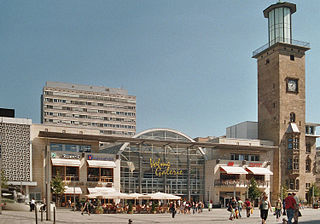
Hagen is the 41st-largest city in Germany. The municipality is located in the state of North Rhine-Westphalia. It is located on the south eastern edge of the Ruhr area, 15 km south of Dortmund, where the rivers Lenne and Volme meet the river Ruhr. As of 31 December 2010, the population was 188,529.
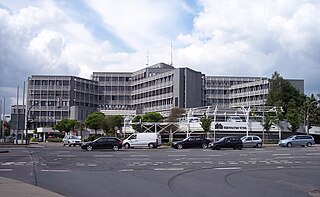
The Märkischer Kreis is a district (Kreis) in central North Rhine-Westphalia, Germany. Neighbouring districts are Unna, Soest, Hochsauerland, Olpe, Oberbergischer Kreis, Ennepe-Ruhr, and the city of Hagen.
The Ennepe-Ruhr-Kreis is a district in the center of North Rhine-Westphalia, Germany. It is part of the southern Ruhr urban area and has ca. 324,000 inhabitants (2012). The district's seat is Schwelm; the largest of its nine towns is Witten.
The Unna district is a Kreis (district) in central North Rhine-Westphalia, Germany. Neighboring authorities are the district of Coesfeld, the city of Hamm, the districts of Soest and Märkischer Kreis, the cities of Hagen and Dortmund, and the district of Recklinghausen.

The SauerlandGerman: [ˈzaʊɐlant](listen) is a rural, hilly area spreading across most of the south-eastern part of North Rhine-Westphalia, in parts heavily forested and, apart from the major valleys, sparsely inhabited.
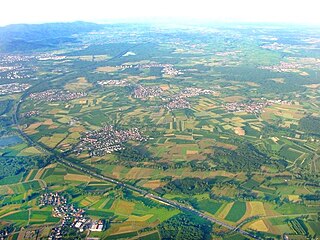
The Breisgau is an area in southwest Germany between the Rhine River and the foothills of the Black Forest. Part of the state of Baden-Württemberg, it centers on the city of Freiburg im Breisgau. The district of Breisgau-Hochschwarzwald, which partly consists of the Breisgau, is named after the Black Forest area. Parts of the Breisgau are also situated in the political districts of Freiburg im Breisgau and Emmendingen.

Dahl, now officially Hagen-Dahl, is a locality within the independent city of Hagen in the southeastern Ruhr, in Germany. It was incorporated into Hagen in 1975 together with Rummenohl and Priorei.

Rummenohl, now officially Hagen-Rummenohl, is a locality within the independent city of Hagen in the eastern part of the Ruhr region, in Germany. It lies in the valley of the river Volme, about 13 km upstream (south) of the city centre of Hagen.

The Volme is a river in North Rhine-Westphalia, Germany, and is a tributary of the river Ruhr. It is 50.5 kilometres (31.4 mi) long, of which about 21 km (13 mi) lie within the city limits of Hagen. Its largest tributary is the Ennepe.

The Ennepe is a river, and a left tributary of the Volme in Northern Sauerland, Germany.
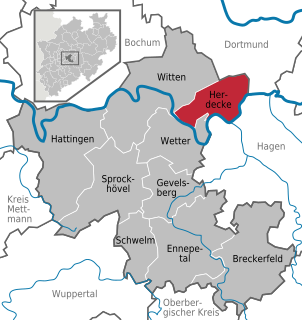
Herdecke is a town in the district of Ennepe-Ruhr-Kreis, North Rhine-Westphalia in Germany. It is located south of Dortmund in the Ruhr Area. Its location between the two Ruhr reservoirs Hengsteysee and Harkortsee has earned it the nickname Die Stadt zwischen den Ruhrseen.

Neuenstadt, usually known as Neuenstadt am Kocher (help·info) is a town in Baden-Württemberg in south-western Germany with 9,600 inhabitants. It consists of Neuenstadt, the villages of Stein am Kocher, Kochertürn, Cleversulzbach and Bürg and the hamlets Brambacher Hof, Buchhof and Lobenbacher Hof. The name Neuenstadt is derived from the “der neuen Stadt” or “New Town” in English.

Hagen-Hohenlimburg, on the Lenne river, is a borough of the city of Hagen in North Rhine-Westphalia, Germany.

Nowogród Bobrzańskipronounced ['nɔˈvɔɡrut bɔˈbʐaɲskʲi] is a town on the Bóbr river in Zielona Góra County, Lubusz Voivodeship, Poland, with 5,165 inhabitants (2019). It is the administrative seat of the Gmina Nowogród Bobrzański. The gmina was created through the integration of Nowogród Bobrzański with the nearby Krzystkowice. It covers the area of 259,4 km2.
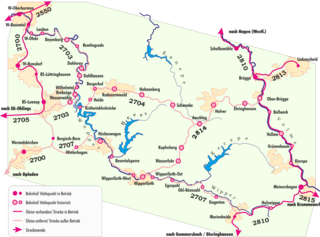
The Hagen–Dieringhausen railway is a mostly single-track and non-electrified railway line from Hagen Hauptbahnhof via Lüdenscheid-Brügge, Meinerzhagen and Gummersbach to Gummersbach-Dieringhausen in the German state of North Rhine-Westphalia.
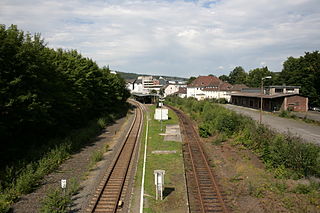
Gummersbach station is on the Hagen–Dieringhausen railway and serves central Gummersbach in the Oberbergische district. Until the 1980s, Dieringhausen station, which is also in Gummersbach, was more important for the city as it had a rail workshop and was a railway junction. Gummersbach station only became more important with the closing of branch lines in the Oberbergische district and the associated loss of significance for Dieringhausen.

The Brügge–Lüdenscheid railway is a single-track, non-electrified branch line in the German state of North Rhine-Westphalia. The 7 km-long line climbs from Lüdenscheid-Brügge station on the Hagen–Dieringhausen railway to Lüdenscheid station.

Lüdenscheid-Brügge station is on the Hagen–Dieringhausen railway from Hagen Hauptbahnhof to Dieringhausen station in the German state of North Rhine-Westphalia. It is classified by Deutsche Bahn as a category 7 station. Because of the branch line to Lüdenscheid, it is classified as a separation station. The station is located on the edge of the Lüdenscheid hamlet of Brügge. There is an island platform with tracks which connects with the bus stop at ground level. The station is known nationally for its elevated disused but preserved signalbox. The station was called Brügge (Westfalen) until 10 December 2017.


















